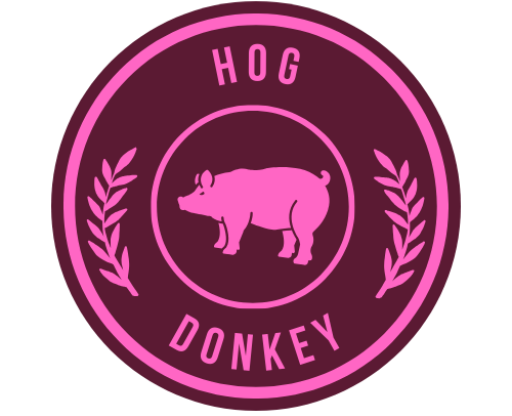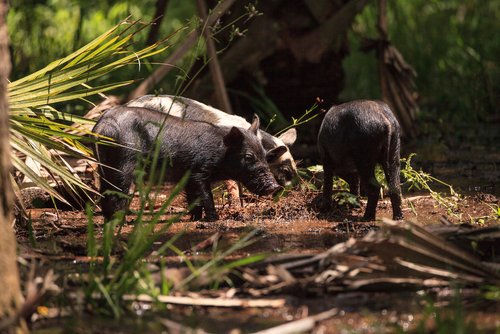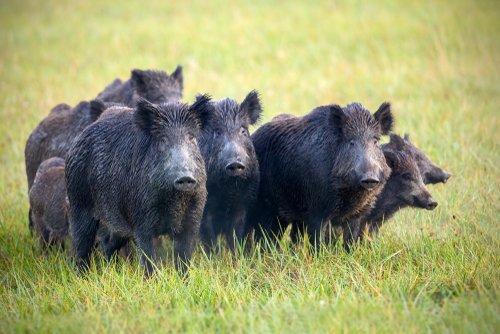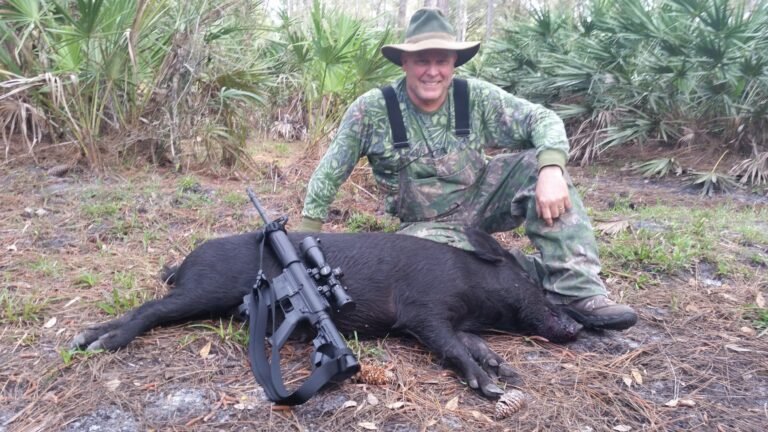The Powerful Guide to Hog Hunting with Dogs in 2024
The deafening bay of my lead dog, Buddy, pierced the pre-dawn silence. After 15 years of hunting hogs with dogs, I knew that sound meant we were about to face off with a monster boar. What happened next taught me one of the most valuable lessons in my hunting career…
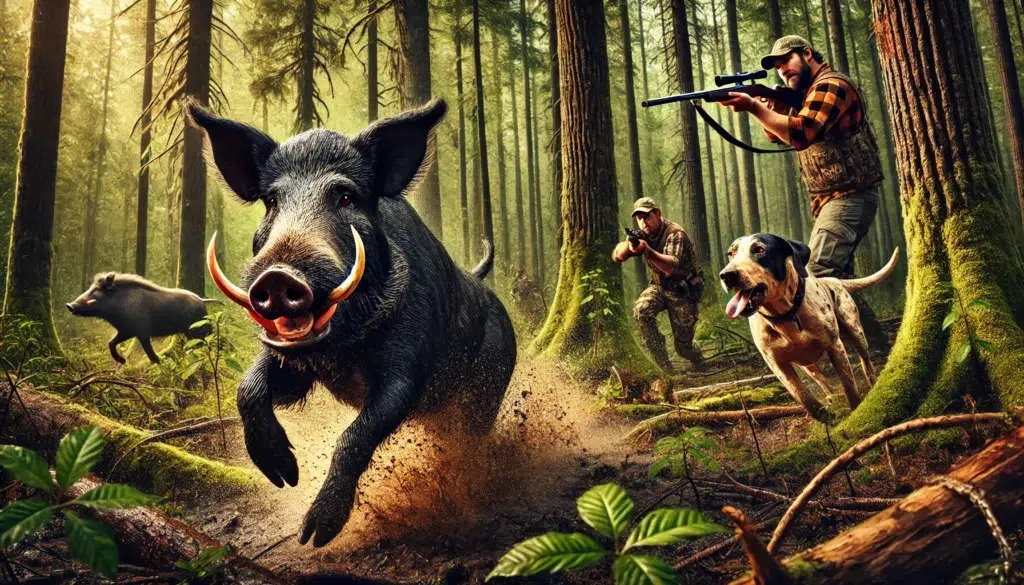
Let me tell you something about hog hunting with dogs – it’s not just about the catch; it’s about the incredible bond you build with your pack. I’ve spent the last 15 years tracking wild boars across the swamps and pine forests of the South, and I’ve learned that success comes down to three things: the right dogs, proper training, and time-tested techniques.
I still remember my first hunt as if it were yesterday. My old mentor Jim handed me the lead to his prized Blackmouth Cur, looked me in the eye, and said, “Son, these dogs aren’t just tools – they’re your partners.” Those words stuck with me through hundreds of successful hunts and more than a few tough lessons.
In this guide, I will share everything I’ve learned about hog hunting with dogs. Whether you’re just starting or looking to improve your success rate, I’ll break down the essential knowledge you need. We’ll cover everything from selecting the perfect bay dogs to training catch dogs and reading dog behavior to staying safe in the field.
Why trust my advice? Well, I’ve trained over 30 successful hunting dogs, helped landowners clear thousands of acres of destructive hogs, and mentored dozens of new hunters in the art of hunting with dogs. But more importantly, I’ve made just about every mistake you can make, and I’m here to help you avoid them.
So grab your gear, call up your dogs, and let’s dive into the wild world of hog hunting. Trust me – once you experience the thrill of working with a well-trained pack of hunting dogs, you’ll never want to hunt any other way.
Types of Dogs Used in Hog Hunting
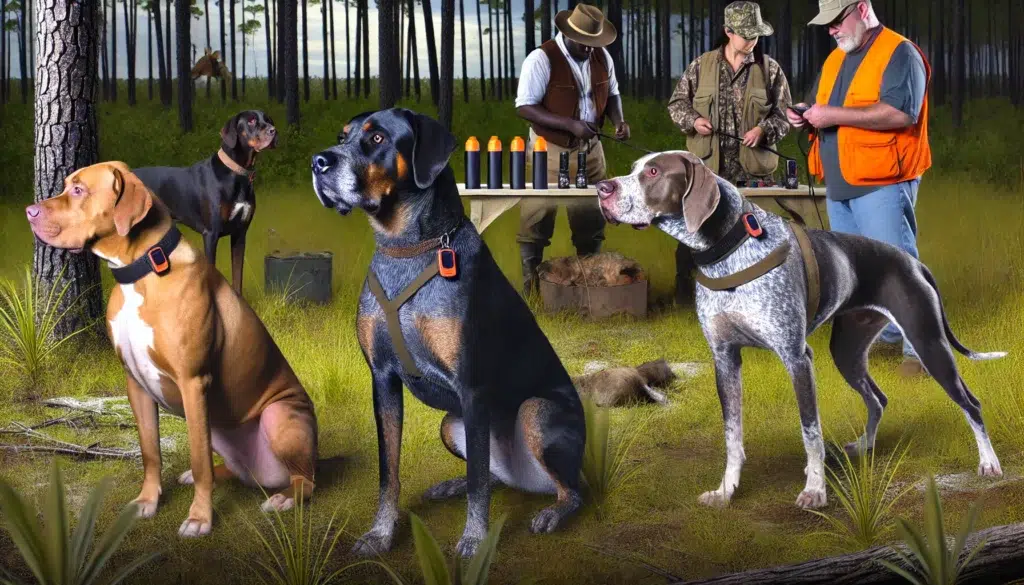
Most folks don’t tell you upfront that success in hog hunting isn’t about having the most expensive dogs or the fanciest gear. It’s about having the right combination of dogs that work together like a well-oiled machine. Let me explain what I’ve learned about choosing and using different hunting dogs.
Bay Dogs: Your Front-Line Warriors
When I first started hunting hogs, I made the rookie mistake of thinking any hunting breed could make a good bay dog. Three lost hogs and one discouraged Labrador later, I learned my lesson. Your bay dogs are your scouts, trackers, and temporary boar-holders, all rolled into one package.
Best Bay Dog Breeds I’ve Worked With:
Blackmouth Curs
- My personal favorite for their versatility
- Excellent nose with enough grit to hold large hogs
- Smart enough to know when to back off
- Storytime: My lead cur, Buck, tracked a 300-pound boar for six miles through a cypress swamp. That kind of determination is priceless.
Catahoula Leopard Dogs
- Natural-born hunters with incredible stamina
- Great in hot weather conditions
- Exceptional at working in thick brush
Mountain Curs
- Compact and agile
- Perfect for rough terrain
- Some of the best “silent trailing” dogs I’ve worked with
Catch Dogs: The Closers
Let me tell you about catch dogs – they’re the linebackers of your hunting team. While bay dogs find and hold, catch dogs move in for the final grab. After losing one of my best catch dogs to a poorly planned catch, I learned that proper training and timing are everything.
Top Catch Dog Breeds:
American Pit Bull Terriers
- My go-to breed for catch work
- Strong enough to hold the biggest hogs
- Smart enough to stay safe when properly trained
- Pro tip: I always run my pits with cut vests; no exceptions
American Bulldogs
- A great alternative to pit bulls
- Excellent stamina
- Strong jaw grip
Building Your Pack: The Magic Numbers
Through years of trial and error, I’ve found this combination works best:
- 2-3 bay dogs
- 1-2 catch dogs
- Never hunt alone – always have a backup catch dog ready
Training Your Pack to Work Together
Here’s where the magic happens. Your dogs must learn to work as a team, not just as individual hunters. I spend 3-4 months training new dogs with my established pack before taking them on serious hunts.
Key Training Points:
Pack Hierarchy
- Let your dogs establish their natural order
- The pack should respect your lead bay dog
- Catch dogs need to learn to wait for the bay
Communication Skills
- Teach basic commands: “Hold,” “Catch,” “Back”
- Use GPS collars for tracking (saved my hide more times than I can count)
- Learn to read your dogs’ different barks
Safety First: Protecting Your Investment
I learned this the hard way: a good hunting dog is worth their weight in gold, and protecting them should be your top priority. Here’s what I always have on hand:
- Cut vests for all dogs
- First aid kit (I’ll share my complete list in a later section)
- Plenty of water
- GPS tracking collars
- Snake bite kits
Common Mistakes I Made (So You Don’t Have To)
- Starting catch dogs too young
- Not giving bay dogs enough solo training time
- Using dogs that aren’t physically conditioned
- Hunting without proper protective gear
Remember what my old mentor Jim told me: “A good hunting dog isn’t born – it’s made through patience, training, and understanding.” Those words ring true every time I head out with my pack.
Training Your Hog Hunting Dogs: From Pup to Pro
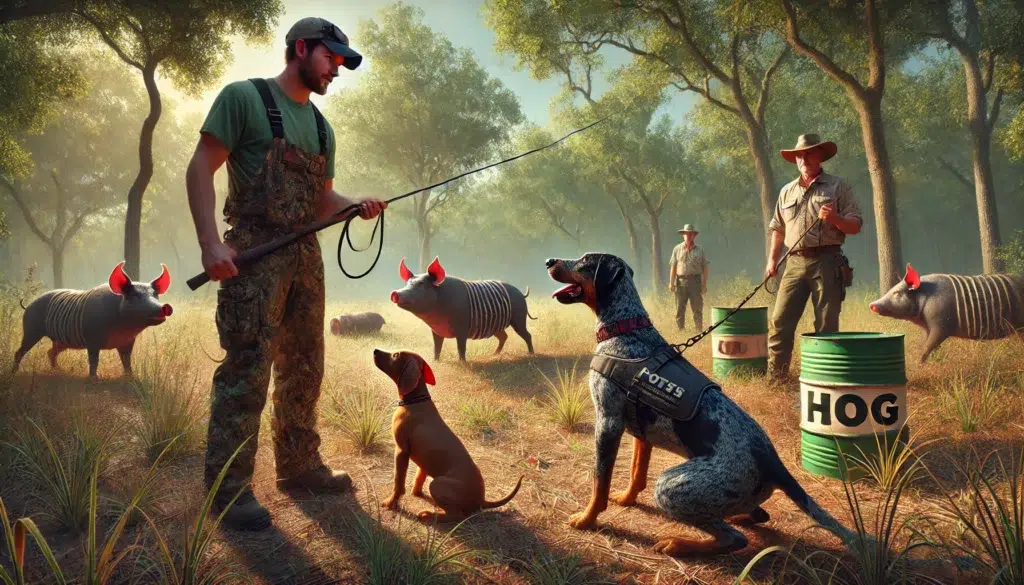
Let me tell you about the day I realized I needed to change my training approach completely. I was out with a young bay dog who’d shown promise, but when we finally cornered a big boar, she tucked her tail and ran. That’s when it hit me – I’d rushed her training. Since then, I’ve developed a step-by-step system that’s produced some of the best hunting dogs I’ve ever worked with.
Starting with Pups: The Foundation
First, forget everything you’ve heard about starting pups on live hogs. That’s a recipe for disaster. Here’s the method I’ve used to train over 20 successful hunting dogs:
Stage 1: Building Drive (3-6 months old)
- Use hog hides to develop scent recognition
- Draglines to create tracking games
- Reward with tons of praise (I keep hot dogs in my pocket)
- Let them watch older dogs work from a distance
Stage 2: Introduction to Hog Sounds (6-8 months)
- Play recorded hog sounds during feeding time
- Use mechanical training dummies
- Practice basic commands: “Hunt,” “Hold,” and “Get back”
- Start GPS collar familiarization
Pro Tip: I lost two good dogs before I learned to train with GPS collars from the start consistently. Now, it’s second nature to them.
Developing Bay Dogs
Your bay dogs are only as good as their training. Here’s my proven method:
Basic Training Progression
- Scent Work (2-3 weeks)
- Hide hog scent in varying locations
- Increase difficulty gradually
- Reward quick finds
- Track Training (1-2 months)
- Start with short, straight tracks
- Graduate to complex trails
- Add water crossings
- Practice in different weather conditions
- Distance Work (2-3 months)
- Extend tracking distance
- Add distractions
- Practice recalls
- Work on stamina
Advanced Bay Training
- Use a catch pen with experienced dogs
- Introduce live hogs safely
- Practice holding technique
- Teach pack coordination
Training Catch Dogs
This is where things get serious. A poorly trained catch dog is dangerous to themselves and others. Here’s my method:
The Basics (8-12 months old)
- Build confidence with roll cages
- Teach grip placement
- Practice release commands
- Work on patience
Advanced Catch Work
- Controlled catches with experienced dogs
- Perfect timing exercises
- Practice safe approaches
- Learn to read hog behavior
Real-World Training Tips
Here’s what I’ve learned from countless hours in the field:
Weather Conditions Matter
- Train in all weather
- Focus on scent work in wet conditions
- Build stamina in heat
- Practice water crossings regularly
Physical Conditioning
- Daily running sessions
- Swimming for low-impact exercise
- Regular hunting simulations
- Gradual endurance building
Problem-Solving Common Issues
Let me share some fixes for problems I see all the time:
Gun Shy Dogs
- Start with distant shots
- Associate gunfire with rewards
- Use blank guns during feeding
- Never force exposure
Poor Stamina
- Structured exercise program
- Proper nutrition (I’ll share my feed program later)
- Regular practice runs
- Gradual distance increases
Lack of Focus
- One-on-one training sessions
- Minimize distractions initially
- Clear command structure
- Consistent rewards
Safety Training: Non-Negotiables
After seeing too many close calls, here are my safety rules:
Protective Gear Training
- Start with vests early
- Practice movement in gear
- Regular gear checks
- Proper fitting sessions
Emergency Recalls
- Practice emergency stops
- Use distinct whistle commands
- Reward immediate response
- Regular refresher training
When to Start Real Hunts
Here’s my checklist before any dog goes on a real hunt:
- Consistently follows basic commands
- Works well with the pack
- Shows proper hog reaction
- Has stamina for long hunts
- Wears gear comfortably
- Responds to emergency recalls
Remember what I always tell new hunters: “A rushed dog is a ruined dog.” Take your time with training, and you’ll end up with a hunting partner that’ll make you proud for years.
The Hunt: What Really Happens in the Field
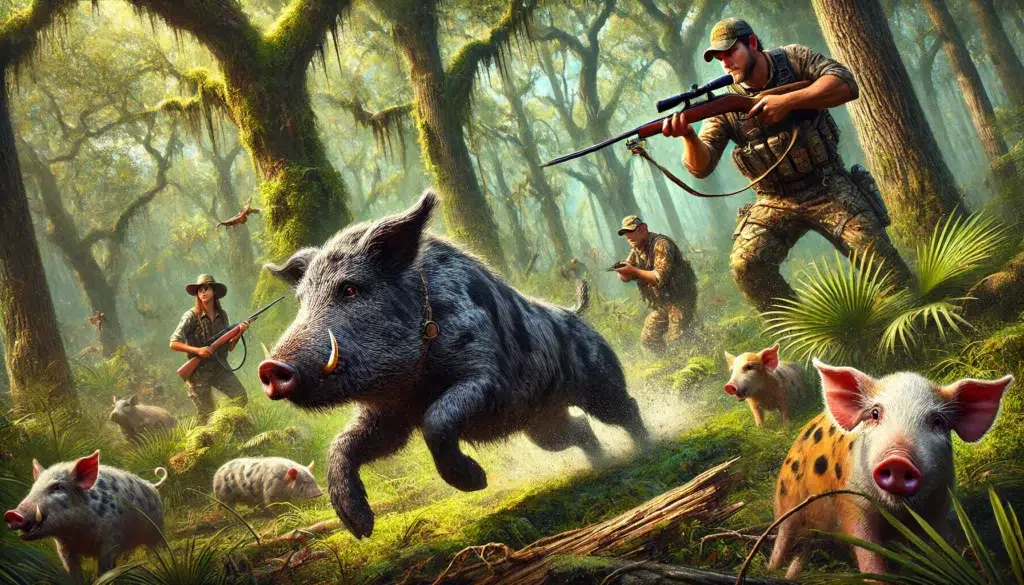
I’ll never forget my first successful night hunt – how my dogs’ eyes reflected in the moonlight, the sound of crackling palmetto fronds, and that heart-pounding moment when we finally cornered a massive boar. Let me share what I’ve learned about making your hunts successful and safe from thousands of hours in the field.
Reading Your Dogs: The Key to Success
Understanding Dog Signals
Let me tell you what I am looking for:
Change in Body Language
- Tail position (high and stiff means they’re onto something)
- Ear movement (forward means they’re locked in)
- Body tension (I can tell when my lead dog Buck “switches on”)
Different Types of Barks
- Location bark (sharp, excited)
- Baying (deep, continuous)
- Warning bark (short, aggressive)
- “Help needed” bark (high-pitched, urgent)
Pro Tip: I record my dogs’ barks on my phone to teach new hunters what to listen for.
Time of Day Strategies
Dawn Patrol (My Favorite)
- Best scent conditions
- Hogs returning from feeding
- Cooler temperatures for dogs
- Better visibility than night hunting
Night Hunting
- Use LED collars (I learned this after losing sight of my dogs one too many times)
- Thermal scopes help
- Focus on feeding areas
- Keep dogs closer than daytime hunts
Weather Factors That Matter
I’ve hunted in everything from drought to downpours. Here’s what works best:
Perfect Conditions
- Light wind (5-10 mph)
- Damp ground
- Overcast sky
- Temperature under 80°F
Challenging Conditions
- Heavy rain (scent washes away)
- High winds (over 15 mph)
- Extreme heat
- Freezing temperatures
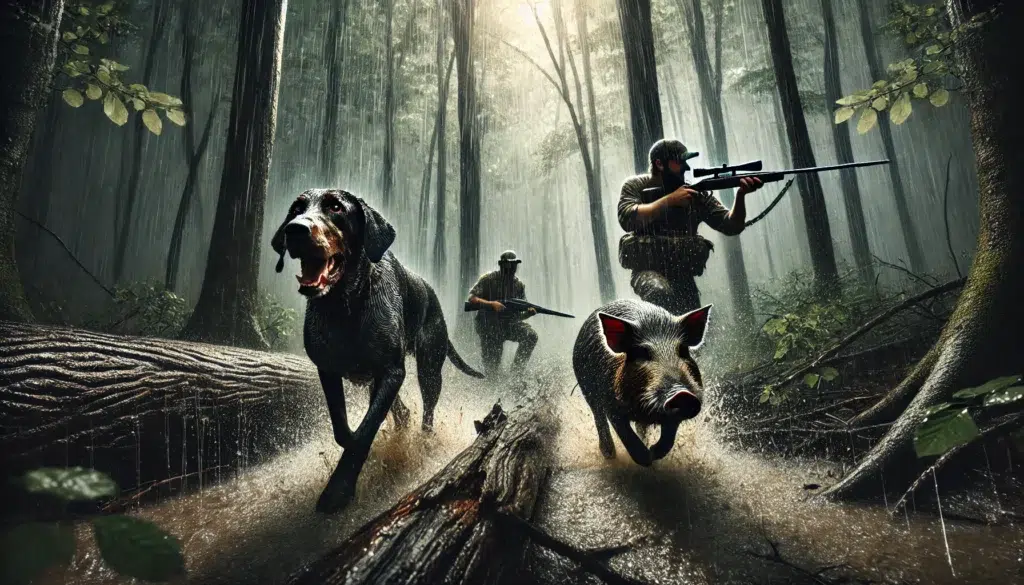
Field Tactics I’ve Refined
The Setup
Starting the Hunt
- Park downwind
- Release bay dogs first
- Keep catch dogs leashed until needed
- Space hunters strategically
Working the Area
- Grid pattern search
- Focus on fresh sign
- Watch wind direction
- Use natural barriers
When Dogs Strike
First Response
- Listen for bark-type
- Check GPS location
- Position catch dogs
- Move quickly but quietly
The Approach
- Watch dog body language
- Keep catch dogs controlled
- Position yourself safely
- Ready your catch gear
Critical Moments: The Catch
This is where experience matters. Here’s my sequence:
Assessment
- Size of hog
- Position in cover
- Dog positioning
- Escape routes
The Catch Sequence
- Release primary catch dog
- Backup dog ready
- Move in quickly
- Secure the hog safely
Safety in the Field
After a close call with a 300-pounder, I never hunt without:
Essential Gear
- First aid kit (dogs and humans)
- GPS tracking system
- Bright LED lights
- Catch pole
- Sharp knife
- Water supply
- Dog trauma kit
Emergency Procedures
Dog Injuries
- Quick assessment protocol
- Field first aid steps
- Emergency contacts ready
- Evacuation plan
Human Safety
- Communication system
- Meet-up points
- First aid procedures
- Emergency exits
Tracking Tips That Work
Here’s what I’ve learned about the following hogs:
Fresh Sign Reading
- Track size and depth
- Rooting patterns
- Rub marks on trees
- Wallows and beds
Using Technology
- GPS mapping
- Dog tracking
- Weather apps
- Satellite imagery
When Things Go Wrong
Let me share some real situations and solutions:
Lost Dogs
- Stay calm (I learned this the hard way)
- Use tracking device
- Work in a grid pattern
- Use recall training
Stuck Hogs
- Approach safely
- Use catch pole
- Keep dogs back
- Work as team
Bad Bays
- Assess danger
- Reposition dogs
- Use terrain
- Know when to pull off
Post-Hunt Procedures
Every successful hunter needs a solid after-action plan:
Dog Check
- Physical inspection
- Hydration check
- Cool down period
- Treat any wounds
Gear Maintenance
- Clean equipment
- Check GPS charges
- Repair any damage
- Restock supplies
Remember what my old mentor told me: “The hunt isn’t over until the dogs are fed and resting.” It’s kept me and my pack safe for years.
Dog Care and Maintenance: The Secret to Success

When I tell folks I’ve had bay dogs work successfully for over 8 years, they’re always shocked. The secret isn’t luck – it’s proper care. Let me share what I’ve learned about keeping hunting dogs in peak condition year after year.
Daily Care Routine
Morning Routine
I start each day with the following:
Health Check
- Temperature check if acting odd
- Paw pad inspection
- Joint flexibility test
- Gum color check (I learned this after catching anemia early in one of my best dogs)
Feeding Program
- High-protein food (28-30% for active dogs)
- Fresh water available 24/7
- Supplements based on activity level
- Split meals (morning/evening)
Pro Tip: I feed my dogs 4 hours before hunting – never hunt on a full stomach.
Training Day Care
On training days, I follow this schedule:
Pre-Training
Warm-up
- 10-minute light exercise
- Stretching routine
- Mental preparation time
- Equipment check
During Training
- Water breaks every 30 minutes
- Heart rate monitoring
- Watch for fatigue signs
- Cool-down periods
Post-Training
Cool Down
- 15-minute walk
- Fresh water (not too much at once)
- Quiet rest time
- Light protein snack
Hunt Day Special Care
Before the Hunt
Physical Prep
- Light meal 4 hours prior
- Full body check
- Gear fitting
- Pad protection application
During the Hunt
- Regular water breaks
- Energy supplements if needed
- Quick injury checks
- Rest periods
After the Hunt
Immediate Care
- Cool down period
- Thorough inspection
- Hydration
- Light snack
Clean-up
- Wound treatment, if needed
- Tick/burr removal
- Paw pad care
- Equipment cleaning
Preventive Healthcare
Here’s my year-round prevention program:
Vaccinations
- Rabies (annual)
- DHPP (every 3 years)
- Leptospirosis (annual)
- Bordetella (bi-annual)
Parasite Prevention
Monthly Treatments
- Heartworm preventive
- Flea/tick medication
- Intestinal deworming
- Inspection schedule
Environmental Control
- Kennel cleaning
- Bedding washing
- Yard maintenance
- Water source cleaning
Emergency Care Kit
After a few close calls, here’s what I keep in my truck:
Basic Supplies
- Gauze and bandages
- Antiseptic solution
- Saline wash
- Hemostatic powder
- Super glue
- Self-adhering wrap
- Scissors
- Tweezers
Advanced Items
- QuikClot
- Emergency blanket
- Hydration supplies
- Pain medication (vet prescribed)
- Antibiotic ointment
- Eyewash
- Wound stapler
- Muzzle
Physical Conditioning Program
Here’s my proven conditioning routine:
Off-Season Training
Cardio
- Swimming (easiest on joints)
- Controlled runs
- Hill work
- Obstacle course
Strength Building
- Pull exercises
- Spring pole work
- Weighted vest walks
- Directed jumping
Active Season Maintenance
- Reduced intensity workouts
- Focus on recovery
- Shorter training sessions
- More rest days
Common Health Issues and Solutions
After years in the field, here’s what I watch for:
Minor Issues
Pad Wear
- Regular inspection
- Pad toughening exercises
- Protective boots when needed
- Quick treatment of cuts
Muscle Strains
- Rest period
- Gentle stretching
- Cold/heat therapy
- Gradual return to activity
Serious Concerns
Heat Issues
- Know the signs
- Immediate cooling
- Emergency vet contacts
- Prevention strategies
Cut Wounds
- Quick assessment
- Field treatment
- When to see a vet
- Prevention methods
Nutrition Program
This is what keeps my dogs going strong:
Daily Nutrition
Base Diet
- Premium kibble (30% protein)
- Added protein sources
- Healthy fats
- Joint supplements
Hunt Day Nutrition
- Pre-hunt meal timing
- Energy supplements
- Electrolyte replacement
- Recovery nutrition
Recovery Protocols
After a hard hunt or training:
Physical Recovery
- 24-hour rest minimum
- Light exercise only
- Extra pad care
- Joint support
Mental Recovery
- Quiet time
- Light play
- Positive reinforcement
- Pack bonding time
Remember what I always say: “A healthy dog is a hunting dog.” Take care of your pack, and they’ll take care of you in the field.
The Big Catches: Stories That Taught Me Something
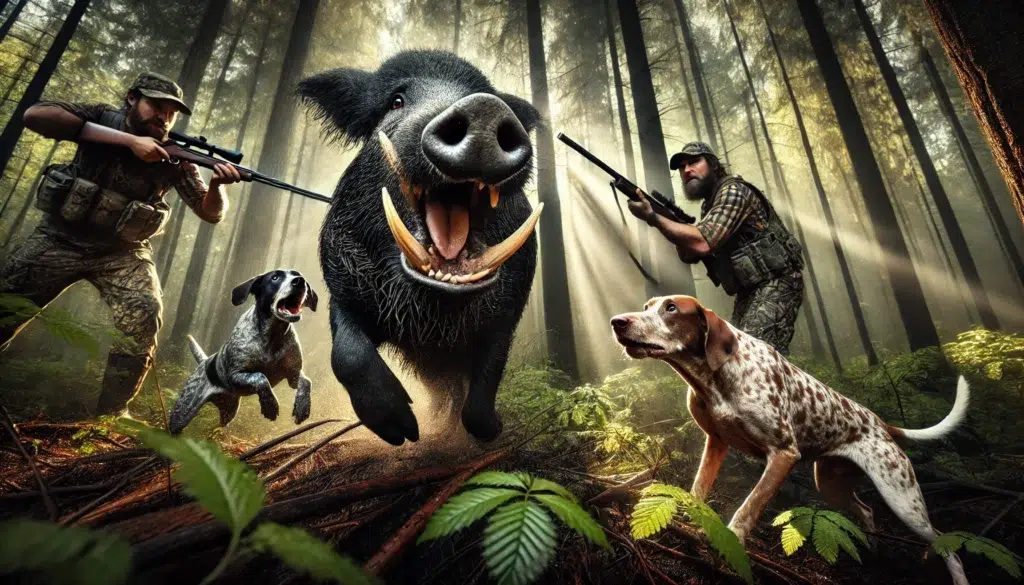
The Palmetto Beast
Tell me about the biggest hog I ever caught – a 375-pound boar that taught me more in one night than I’d learned in a year. It was a muggy Florida evening when my lead dog, Buck, caught a scent that changed his demeanor.
What I Learned:
- Big hogs often travel alone
- Old boars are surprisingly quiet
- Dog behavior changes with large hogs
- Patience pays off
The Three-Hour Track
One of my proudest moments wasn’t about size – it was about persistence. My young Catahoula, Belle, tracked a medium-sized boar through three creek crossings and miles of thick brush.
Key Takeaways:
- Trust your dog’s nose
- Stay hydrated (dogs and hunters)
- GPS tracking is worth its weight in gold
- Sometimes the longest hunts are the best ones
Mistakes That Made Me Better
The Night I Lost My Best Dog (Temporarily)
I’ll never forget the panic when my GPS collar failed. After four hours of searching, here’s what I learned:
- Equipment Lessons
- Always carry backup batteries
- Have a secondary tracking method
- Keep spare collars ready
- Mark your dogs with reflective gear
- Search Strategies
- Work in grids
- Use sound signals
- Know your dogs’ habits
- Have a search plan ready
The Overconfidence Trap
I had a close call with a big boar because I got cocky. Here’s what it taught me:
- Safety First
- Never rush the catch
- Always have backup
- Read the whole situation
- Trust your gut
- Better Planning
- Check equipment twice
- Position hunters strategically
- Have an escape route
- Keep catch dogs fresh
Building Relationships with Landowners
Over the years, I’ve built a network of properties to hunt. Here’s how:
Making Connections
- First Contact
- Professional approach
- Clear communication
- Written agreements
- Respect boundaries
- Maintaining Relationships
- Regular updates
- Share the meat
- Fix what you disturb
- Show appreciation
Conservation Impact
This isn’t just hunting – it’s land management. Here’s what I’ve seen:
Property Improvement
- Damage Prevention
- Regular population control
- Strategic timing
- Focus on problem areas
- Track results
- Environmental Benefits
- Protect native species
- Reduce crop damage
- Preserve water sources
- Maintain balance
Community Building
The hog hunting community has given me so much. Here’s how I give back:
Mentoring New Hunters
- Teaching Basics
- Safety first
- Dog handling
- Reading sign
- Equipment use
- Building Skills
- Hands-on training
- Field experience
- Problem-solving
- Safety protocols
Memorable Lessons
Here are some sayings I live by:
- “A rushed hunt is a failed hunt”
- Take time to plan
- Read the signs
- Position properly
- Stay patient
- “Your dogs are only as good as their training”
- Consistent practice
- Clear commands
- Regular reinforcement
- Trust building
- “Safety first, success second”
- Proper equipment
- Team coordination
- Emergency plans
- Regular checks
Future of the Sport
What I see coming and how to prepare:
Evolving Technology
- New Tools
- Better GPS systems
- Improved protective gear
- Advanced training aids
- Better communication devices
- Staying Traditional
- Core skills matter
- Dog work is still key
- Personal connection
- Community values
Tips for Success
After years in the field, here’s what matters most:
- Essential Habits
- Regular training
- Equipment maintenance
- Physical fitness
- Community involvement
- Mental Approach
- Stay humble
- Keep learning
- Share knowledge
- Respect the hunt
Final Thoughts
Remember what my old mentor told me: “The best hunters aren’t the ones with the most catches – they’re the ones with the healthiest dogs and the most respect for the sport.”
